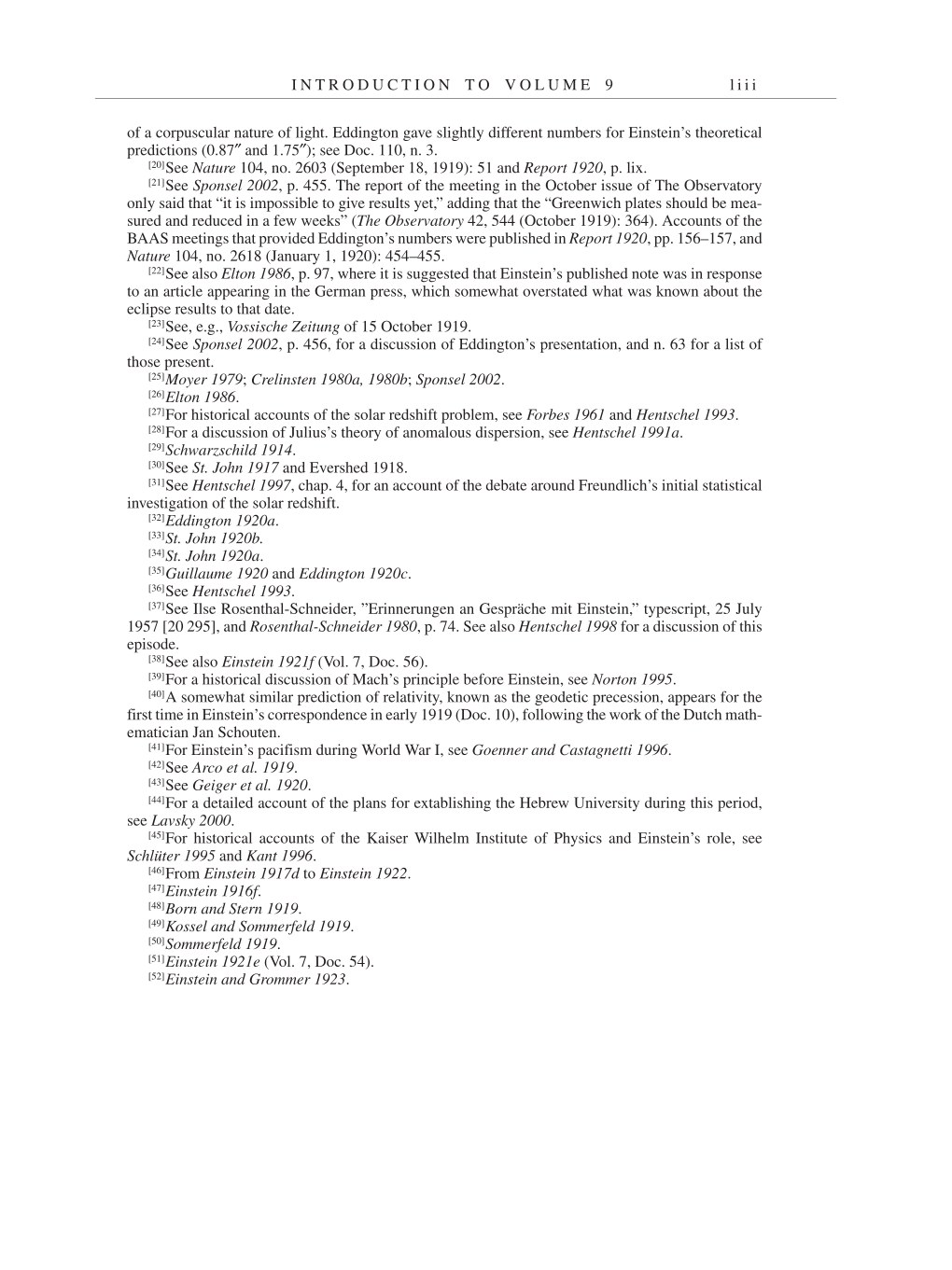I N T R O D U C T I O N T O V O L U M E 9 l i i i
of a corpuscular nature of light. Eddington gave slightly different numbers for Einstein’s theoretical
predictions (0.87″ and 1.75″); see Doc. 110, n. 3.
[20]See Nature 104, no. 2603 (September 18, 1919): 51 and Report 1920, p. lix.
[21]See Sponsel 2002, p. 455. The report of the meeting in the October issue of The Observatory
only said that “it is impossible to give results yet,” adding that the “Greenwich plates should be mea-
sured and reduced in a few weeks” (The Observatory 42, 544 (October 1919): 364). Accounts of the
BAAS meetings that provided Eddington’s numbers were published in Report 1920, pp. 156–157, and
Nature 104, no. 2618 (January 1, 1920): 454–455.
[22]See also Elton 1986, p. 97, where it is suggested that Einstein’s published note was in response
to an article appearing in the German press, which somewhat overstated what was known about the
eclipse results to that date.
[23]See, e.g., Vossische Zeitung of 15 October 1919.
[24]See Sponsel 2002, p. 456, for a discussion of Eddington’s presentation, and n. 63 for a list of
those present.
[25]Moyer 1979; Crelinsten 1980a, 1980b; Sponsel 2002.
[26]Elton 1986.
[27]For historical accounts of the solar redshift problem, see Forbes 1961 and Hentschel 1993.
[28]For a discussion of Julius’s theory of anomalous dispersion, see Hentschel 1991a.
[29]Schwarzschild 1914.
[30]See St. John 1917 and Evershed 1918.
[31]See Hentschel 1997, chap. 4, for an account of the debate around Freundlich’s initial statistical
investigation of the solar redshift.
[32]Eddington 1920a.
[33]St. John 1920b.
[34]St. John 1920a.
[35]Guillaume 1920 and Eddington 1920c.
[36]See Hentschel 1993.
[37]See Ilse Rosenthal-Schneider, ”Erinnerungen an Gespräche mit Einstein,” typescript, 25 July
1957 [20 295], and Rosenthal-Schneider 1980, p. 74. See also Hentschel 1998 for a discussion of this
episode.
[38]See also Einstein 1921f (Vol. 7, Doc. 56).
[39]For a historical discussion of Mach’s principle before Einstein, see Norton 1995.
[40]A somewhat similar prediction of relativity, known as the geodetic precession, appears for the
first time in Einstein’s correspondence in early 1919 (Doc. 10), following the work of the Dutch math-
ematician Jan Schouten.
[41]For Einstein’s pacifism during World War I, see Goenner and Castagnetti 1996.
[42]See Arco et al. 1919.
[43]See Geiger et al. 1920.
[44]For a detailed account of the plans for extablishing the Hebrew University during this period,
see Lavsky 2000.
[45]For historical accounts of the Kaiser Wilhelm Institute of Physics and Einstein’s role, see
Schlüter 1995 and Kant 1996.
[46]From Einstein 1917d to Einstein 1922.
[47]Einstein 1916f.
[48]Born and Stern 1919.
[49]Kossel and Sommerfeld 1919.
[50]Sommerfeld 1919.
[51]Einstein 1921e (Vol. 7, Doc. 54).
[52]Einstein and Grommer 1923.
